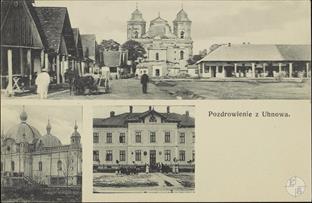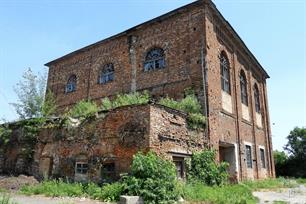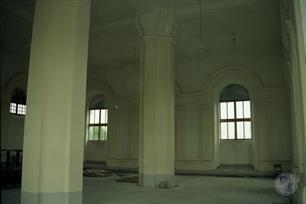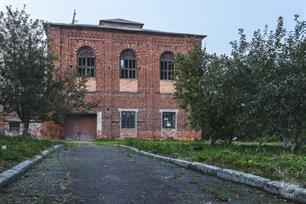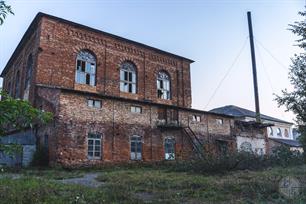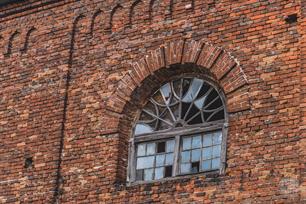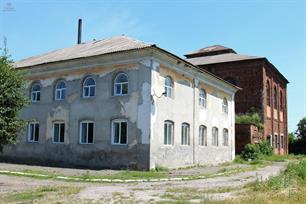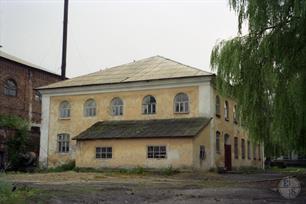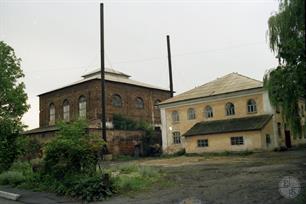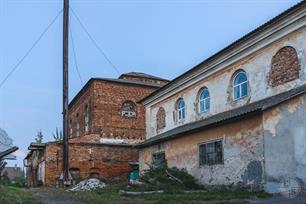Uhniv
Chervonohrad district, Lviv region
Sources:
- Słownik geograficzny Krуlestwa Polskiego i innych krajуw słowiańskich, vol. 12, eds. F. Sulimierski, W. Walewski, B. Chlebowski, Warsaw 1892, p. 755.
- Encyclopedia of Jewish Life Before and During the Holocaust, vol. 3, eds. S. Spector, G. Wigoder, New York 2001, p. 1357.
- Virtual Shtetl. Uhniv
- Jewish Cemeteries Initiative. Uhniv Jewish Cemetery
Photo:
- Benjamin Lukin, Boris Khaimovich, Eva Maria Kraiss: Center for Jewish art. Uhniv
- Сергій Хом'як. Синагога в Угніві
- Biblioteka Narodowa Polona. Uhnow
- Słownik geograficzny Krуlestwa Polskiego i innych krajуw słowiańskich, vol. 12, eds. F. Sulimierski, W. Walewski, B. Chlebowski, Warsaw 1892, p. 755.
- Encyclopedia of Jewish Life Before and During the Holocaust, vol. 3, eds. S. Spector, G. Wigoder, New York 2001, p. 1357.
- Virtual Shtetl. Uhniv
- Jewish Cemeteries Initiative. Uhniv Jewish Cemetery
Photo:
- Benjamin Lukin, Boris Khaimovich, Eva Maria Kraiss: Center for Jewish art. Uhniv
- Сергій Хом'як. Синагога в Угніві
- Biblioteka Narodowa Polona. Uhnow
Uhniv (ukr. Угнів) is the smallest city of Ukraine.
The beginnings of Jewish settlement in Uhnуw (currently Uhniv) date back to the 16th century, but the Jewish population only started to develop more dynamically at the end of the 18th century.
The earliest records about Jews in Uhniv date from 1550. In 1635, 30 Jewish houses existed.
In 1720, nearly 17 Jews lived in Uhniv.
During the 17th and 18th century, the main spheres local Jews were engaged in was the leasing of land and petty trade.
By the late 18th century, the local community became independent from the kehila of Zhovkva.
In 1880, the town had 1,843 Jewish inhabitants, constituting ca. 43% of the total population (4,277). Soon after, their number increased in 1900 to 2,140 people, or ca. 50% of all the inhabitants.
At that point, the Jewish population started to be represented in the Municipal Council.
The beginnings of Jewish settlement in Uhnуw (currently Uhniv) date back to the 16th century, but the Jewish population only started to develop more dynamically at the end of the 18th century.
The earliest records about Jews in Uhniv date from 1550. In 1635, 30 Jewish houses existed.
In 1720, nearly 17 Jews lived in Uhniv.
During the 17th and 18th century, the main spheres local Jews were engaged in was the leasing of land and petty trade.
By the late 18th century, the local community became independent from the kehila of Zhovkva.
In 1880, the town had 1,843 Jewish inhabitants, constituting ca. 43% of the total population (4,277). Soon after, their number increased in 1900 to 2,140 people, or ca. 50% of all the inhabitants.
At that point, the Jewish population started to be represented in the Municipal Council.
The relations between Jews and Ukrainians in Uhniv were always strained, and anti-Semitic incidents took place from time to time. Cossack raids of the town during World War I further worsened the relations between ethnic groups and hastened the pauperisation of the local community. In addition, the Jewish community was decimated by the cholera epidemic of 1915.
In the mid-19th century, Hasidism became the dominant movement among the Uhniv Jewry. However, in the interwar period, Zionists began to gain more and more influence.
Avigdor Spitzer was one of the Zionist leaders of Uhniv. He maintained a school of Hebrew language in his house.
At that time, the economic situation of the Jews was very difficult. They were charged with high taxes, and Jewish tradesmen were facing strong competition from Ukrainian cooperatives.
In 1931, the Jewish population numbered 2,020 individuals.
Between September 1939 and June 1941, Uhniv was occupied by the Soviets. The Red Army was then pushed out of the town by Germans, who immediately introduced repressions against the Jewish population.
At the end of July 1942, Germans organised an extermination action in Rawa Ruska (Rava-Ruska), during which ca. 2,000 Jews were transported to the Belzec extermination camp. Among them were several hundred Jews from Niemirуw (Nemyriv) and Uhniv.
A few months later, in October 1942, the remaining Jews from Uhnivwere deported to the Rawa Ruska Ghetto. It had a total population of ca. 10,000 people, including Jews from Lubycza Krуlewska (Liubycha Korolivska), Magierуw (Maheriv), Niemirуw, and Potylicz (Potelych).
The subsequent liquidation action was carried out between 7 and 11 December 1942 – ca. 5,000 Jews were murdered on the spot, and 2,500 were transported to the Belzec extermination camp.
In the mid-19th century, Hasidism became the dominant movement among the Uhniv Jewry. However, in the interwar period, Zionists began to gain more and more influence.
Avigdor Spitzer was one of the Zionist leaders of Uhniv. He maintained a school of Hebrew language in his house.
At that time, the economic situation of the Jews was very difficult. They were charged with high taxes, and Jewish tradesmen were facing strong competition from Ukrainian cooperatives.
In 1931, the Jewish population numbered 2,020 individuals.
Between September 1939 and June 1941, Uhniv was occupied by the Soviets. The Red Army was then pushed out of the town by Germans, who immediately introduced repressions against the Jewish population.
At the end of July 1942, Germans organised an extermination action in Rawa Ruska (Rava-Ruska), during which ca. 2,000 Jews were transported to the Belzec extermination camp. Among them were several hundred Jews from Niemirуw (Nemyriv) and Uhniv.
A few months later, in October 1942, the remaining Jews from Uhnivwere deported to the Rawa Ruska Ghetto. It had a total population of ca. 10,000 people, including Jews from Lubycza Krуlewska (Liubycha Korolivska), Magierуw (Maheriv), Niemirуw, and Potylicz (Potelych).
The subsequent liquidation action was carried out between 7 and 11 December 1942 – ca. 5,000 Jews were murdered on the spot, and 2,500 were transported to the Belzec extermination camp.

- Home
- Shtetls
- Vinnytsia region
- Volyn region
- Dnipro region
- Donetsk region
- Zhytomyr region
- Zakarpattia region
- Zaporizhzhia region
- Ivano-Frankivsk region
- Kyiv region
- Kropyvnytskyi region
- Luhansk region
- Lviv region
- Mykolayiv region
- Odessa region
- Poltava region
- Rivne region
- Sumy region
- Ternopil region
- Kharkiv region
- Kherson region
- Khmelnytskyi region
- Chernihiv region
- Chernivtsi region
- Cherkasy region
- Crimea
- Synagogues
- Cemeteries
- Objects & guides
- Old photos
- History
- Contact
Jewish towns of Ukraine
Jewish towns of Ukraine
My shtetl
My shtetl
Donate
